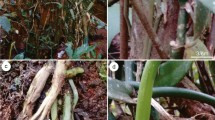Abstract
The root structure in members of the Lemnaceae is important to plant researchers, because changes during cell differentiation can more easily be monitored in short roots with determinate growth. Here, the structural organization and cellular differentiation of the root system was assessed in the highly reducedSpirodela polyrhiza. While protected by a prophyllous sheath, rapid cell division occurred in the apical and vascular regions of the immature roots. Concentric rings of endodermis with Casparian strips, cortex, and epidermis enclosed a single vascular strand. The cytoplasmic density of the cortex was high at the apex, but decreased progressively along the root. The root root cap junction, closely attached at initiation, later became a distinct boundary layer filled with fibrillar materials. Chloroplasts were well distributed. Numerous plasmodesmata indicated the likely symplastic movement of ions and metabolites in the root system as well as further into the reduced plant body. A high cytoplasmic density at the apex and extreme vacuolization along the cortex provided possible explanations for the considerable distribution of weight along the roots of the plant body. These conditions probably enable the root tip to serve as a pendulum against water motion.
Similar content being viewed by others
Abbreviations
- B:
-
boundary layer
- C:
-
Chloroplast
- Cc:
-
companion cell
- G:
-
inner cortical layer
- Cm:
-
middle cortical layer
- Co:
-
outer cortical layer
- Cw:
-
cell wall
- E:
-
Epidermis
- En:
-
Endodermis
- F:
-
Frond
- G:
-
Golgi body
- I:
-
intercellular space
- M:
-
Mitochondria
- M:
-
microorganism
- mt:
-
microtubule
- N:
-
Nucleus
- P:
-
P-plastid
- Pd:
-
plasmodesmata
- Ps:
-
prophyllous sheath
- R:
-
Root
- Rc:
-
root cap cell
- er:
-
endoplasmic reticulum
- S:
-
starch grain
- Sc:
-
sieve cell
- T:
-
tracheary element
- V:
-
vacuole
- Vt:
-
vascular tissue
Literature cited
Barlow PW, Rosl TL, Gunning BES (1982) Nuclear and cytoplasmic changes during early stages of cell differentiation in roots of the water-fern,Azolla pinnata. Protoplasma112: 205–216
Barnabas AD (1996) Casparian band-like structures in the root hypodermis of some aquatic angiosperms. Aquat Bot55: 217–225
Barnabas AD, Arnoll HJ (1987) Zostera capens/s Setchell: Root structures in relation to function. Aquat Bot27: 309–322
Duong TP, Tiedje JM (1985) Nitrogen fixation by naturally occurring duckweed-cyanobacterial associations. Can J Microbiol31: 327–330
Echlin P (1992) Low-Temperature Microscopy and Analysis. Plenum Press, New York, pp 349–411
Echlin R Pawley JB, Hayes TL (1979) Freeze-fracture scanning electron microscopy ofLemna minor L. Scan Electron Microsc3: 69–76
Echlin P, Lai CE, Hayes TL, Hook C (1980) Elemental analysis of frozen-hydrated differentiating phloem parenchyma in roots ofLemna minor L. Scan Electron Microsc2: 383–394
Echlin R Lai CE, Hayes TL (1981) The distribution and relative concentration of potassium in the root-tips ofLemna minor L. analyzed using low-temperature x-ray microanalysis. Scan Electron Microsc2: 489–498
Echlin R Lai CE, Hayes TL (1982) Low-temperature X-ray microanalysis of the differentiating vascular tissue in root tips ofLemna minor L. J Microsc126: 285–306
Federle TW, Schwab BS (1989) Mineralization of surfactants by microbiota of aquatic plants. Appl Environ Microbiol55: 2092–2094
Gunning BES, Sleer MW (1996) Plant Cell Biology: Structure and Function. Jones and Bartlett Publishers, Boston, 51–60
Gunning BES, Hughes JE, Hardham AR (1978) Formative and proliferative cell divisions, cell differentiation, and developmental changes in the meristem ofAzolla roots. Planta143: 121–144
Hillman WS (1961) The Lemnaceae, or duckweeds: A review of the descriptive and experimental literature. Bot Rev27: 221–237
Ice J, Couch R (1987) Nutrient absorption by duckweed. J Aquat Plant Manage25: 30–31
Inskeep WP, Bloom PR (1985) Extinction coefficients of chlorophyll a and b in N,N-dimethylformamide and 80% acetone. Plant Physiol77: 483–485
Kim IS (2006) Changes in the plastid ultrastructure duringSedum rotundifolium leaf development. J Plant Biol49: 376–383
Landolt E (1998) Anatomy of the Lemnaceae (duckweeds).In E Landolt, I Jager-Zurn, RAA Schnell, eds. Extreme Adaptations in Angiospermous Hydrophytes. Bomtraeger, Berlin, 1–127
Lemon GD, Posluszny U (2000) Comparative shoot development and evolution in the Lemnaceae. Intl J Plant Sci161: 733–748
Melaragno JE, Walsh AM (1976) Ultrastructural features of developing sieve elements inLemna minor L. I. The protoplast. Amer J Bot63: 1145–1149
Meijer LE, Sullon DL (1987) Influence of plant position on growth of duckweed. J Aquat Plant Manage25: 28–30
Moran R, Poralh D (1980) Chlorophyll determination in intact tissues using N,N-dimethylformamide. Plant Physiol65: 478–479
Muhonen M, Showman J, Couch R (1983) Nutrient absorption bySpirodela polyrhiza. J Aquat Plant Manage21: 107–109
Noboru M (1990) Water Plants. Woongjin Publishing Co., Seoul, 9–53 (in Korean)
Pedersen O, Sand-Jensen K (1993) Water transport in submerged macrophytes. Aquat Bot47: 1 55–1 74
Rascio N, Mariani P, Tommasini E, Bodner M, Larcher W (1991) Photosynthetic strategies in leaves and stems ofEgeria densa. Planta185: 297–303
Scullhorpe CD (1967) The Biology of Aquatic Vascular Plants. Edward Arnold Ltd., London, 176–216
Underwood GJC, Baker JH (1991) The effect of various aquatic bacteria on the growth and senescence of duckweed(Lemna minor). J Appl Bacteriol70: 192–196
Walsh MA, Melaragno J (1976) Ultrastructural features of developing sieve elements inLemna minor L. II. Sieve plate and lateral sieve areas. Amer J Bot63: 1174–1183
Whatley JM, Gunning BES (1981) Chloroplast development inAzolla roots. New Phytol89: 129–138
Zuberer DA (1984) Microbial colonization of some duckweeds (Lemnaceae): Examination by scanning and transmission electron and light microscopy. Aquat Bot18: 275–285
Author information
Authors and Affiliations
Corresponding author
Rights and permissions
About this article
Cite this article
Kim, I. Development of the root system inSpirodela polyrhiza (L.) schleiden (Lemnaceae). J. Plant Biol. 50, 540–547 (2007). https://doi.org/10.1007/BF03030707
Received:
Accepted:
Issue Date:
DOI: https://doi.org/10.1007/BF03030707




